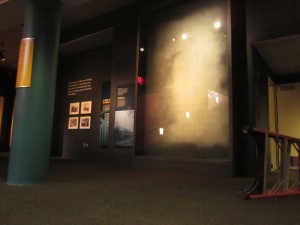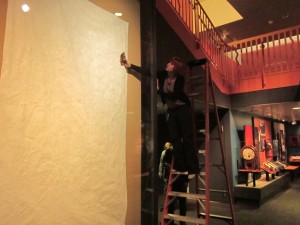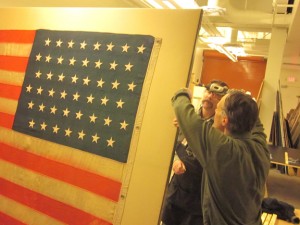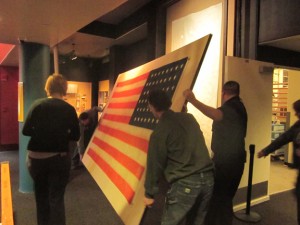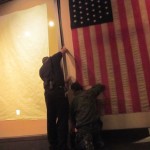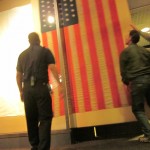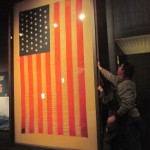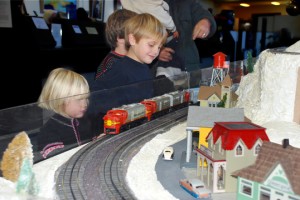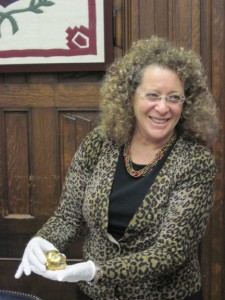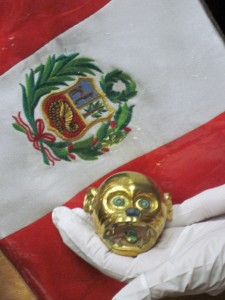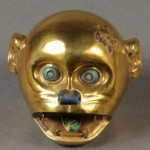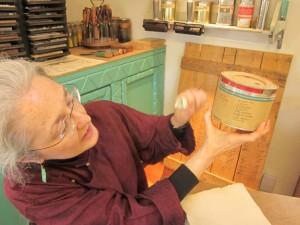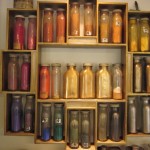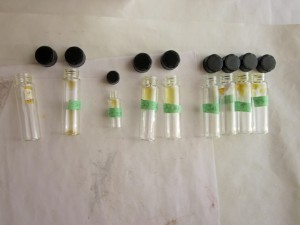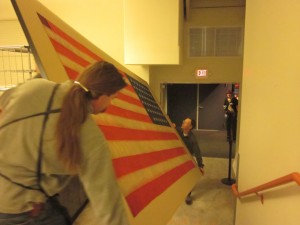 It took some very careful maneuvering to get it into place, but in honor of next year’s New Mexico Centennial, our 47-star flag was moved into its display case today. The fragile flag was secured to 5-by-9-foot board (by rough estimate) that had to be transported down two flights and through the lower-level Collections Storage Area to join our existing statehood exhibit.
It took some very careful maneuvering to get it into place, but in honor of next year’s New Mexico Centennial, our 47-star flag was moved into its display case today. The fragile flag was secured to 5-by-9-foot board (by rough estimate) that had to be transported down two flights and through the lower-level Collections Storage Area to join our existing statehood exhibit.
(That’s Palace Press Printer Jame Bourland on the near end and Exhibition Preparator Doug Jewell on the other slooooowly moving it through, at left.)
We readily admit that the flag is unofficial, maybe even a tad illegal. By federal law, new stars could only be added to the U.S. flag once a year: on July 4th. But 39 days after New Mexico’s Jan. 6, 1912 admission, Arizona sneaked in, robbing us of the chance to have a flag with only our additional star. That didn’t stop manufacturers from churning out a few, including the three in our possession.
They’ll be rotated through display, a year at a time, to spare them from too much exposure to light. The first one up is the monster-sized version, 65×115¾”. It came to us via a donor in Drexel City, Penn., who said her father had owned it. Getting it into condition to be displayed came courtesy of conservation work done by Rebecca Tinkham Hewett and Cindy Lee Scott.
Here’s a photographic journey of what went down (or is that up?) today:
The “before” wall, above. (This is at the bottom of the staircase from the mezzanine; the wall used to have a huge Depression-era photograph on it.)
Cindy checks the existing light levels to determine how much adjustment will be needed in their brightness to protect the flag.
Doug attaches a rail to what will be the top of the exhibition case.
At one point, he had to retreat and let Cindy fix part of the edging with that most trusty of any conservator’s tool: A Swiss Army knife.
After wrestling it out of the room, along the way managing to avoid any number of perilous obstructions, they laid it flat then lifted one end to a vertical position. (“It’s like Iwo Jima,” James said to appreciative laughter.) Then — one, two, three — they pushed it into its exhibition case:
We still have a few Centennial tricks up our sleeve, including a front-window display that will let you pose in a replica 1912 parade float, and a yearlong schedule of statehood-related Brainpower & Brownbags lectures. On Jan. 6, the United States Postal Service will join us for a First-Day-of-Issue event for the official Centennial stamp, designed by New Mexico artist Doug West. It’s all part of what we call 47 Stars, an installation supporting our main exhibition’s section about statehood.
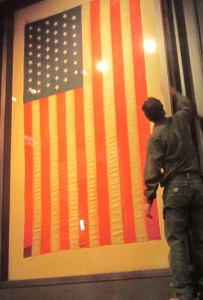 In the meantime, we’re justifiably proud of all the staffers who worked hard to bring this once-depressing (or at least Depressioning) wall in our museum to life.
In the meantime, we’re justifiably proud of all the staffers who worked hard to bring this once-depressing (or at least Depressioning) wall in our museum to life.
Come by and check it out, along with all the other pieces of the statehood story we have to tell.

